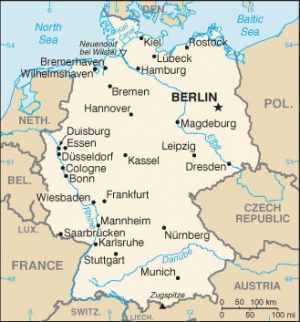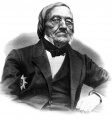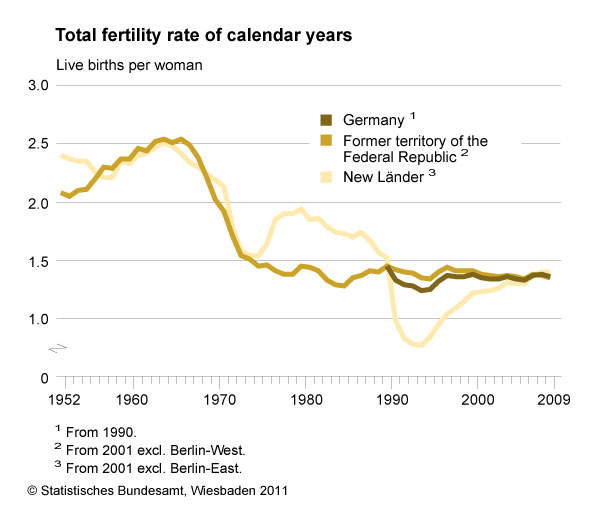Germany Statistics
Introduction
This page links to the current online resources available to explore German population and birth data.
| Statistics Links: Introduction | Reports | World Population | World Fertility | World Infant Mortality | Maternal Mortality | Australia | Brazil | Canada | China | Germany | India | Indonesia | Europe | Myanmar | Netherlands | Spain | United Kingdom | Romania | Uganda | United States | BGD Tutorial - Applied Embryology and Teratology | National Perinatal Statistics Unit | AIHW | Category:Statistics | |
|
People
- Otto Leonhardt Heubner (1843-1926) was appointed to the first professorship in Germany exclusively devoted to pediatrics at the Charité Children's Clinic of Berlin University. He studied internal medicine in Leipzig under Carl Reinhold August Wunderlich and Ernst Leberecht Wagner, his early research involved anatomical studies of the circulation of the brain, from which he described syphilitic endarteritis (Heubner's disease) and the medial striate artery (recurrent artery of Heubner). He then with the Max Rubner, studied energy metabolism in infancy, creating the notion of the nutrition quotient.[1]
Some Recent Findings
|
| Older papers |
|---|
| These papers originally appeared in the Some Recent Findings table, but as that list grew in length have now been shuffled down to this collapsible table.
See also the Discussion Page for other references listed by year and References on this current page.
|
Germany - Total Fertility Rate
Mean Age of Mothers
| Specification | Unit | 2006 | 2007 | 2008 | 2009 |
| Total | Age | 30.1 | 30.3 | 30.4 | 30.4 |
|
Married mothers (Referring to children from the present marriage) | |||||
| Total | Age | 31.1 | 31.2 | 31.3 | 31.4 |
| At birth of first child | Age | 29.8 | 29.9 | 30.1 | 30,2 |
| At birth of second child | Age | 31.5 | 31.6 | 31.8 | 31,9 |
| At birth of third child | Age | 32.9 | 33.0 | 33.2 | 33.3 |
| Unmarried mothers | Age | 28.0 | 28.2 | 28.3 | 28.5 |
| Data Source: German Statistics
Links: Germany Statistics | maternal age | |||||
General Statistics
- 80,457,737 (July 2018 est.)
- country comparison to the world: 19
Age structure
(2011 est.)
- 0-14 years: 13.3% (male 5,569,390/female 5,282,245)
- 15-64 years: 66.1% (male 27,227,487/female 26,617,915)
- 65 years and over: 20.6% (male 7,217,163/female 9,557,634)
Median age
(2011 est.)
- total: 44.9 years
- male: 43.7 years
- female: 46 years
Population growth rate
- -0.208% (2011 est.)
- country comparison to the world: 212
Birth rate
- 8.3 births/1,000 population (2011 est.)
- country comparison to the world: 219
Death rate
- 10.92 deaths/1,000 population (July 2011 est.)
- country comparison to the world: 39
Sex ratio
- at birth: 1.055 male(s)/female
- under 15 years: 1.05 male(s)/female
- 15-64 years: 1.04 male(s)/female
- 65 years and over: 0.72 male(s)/female
- total population: 0.97 male(s)/female (2011 est.)
Infant mortality rate
- total: 3.54 deaths/1,000 live births
- country comparison to the world: 208
- male: 3.84 deaths/1,000 live births
- female: 3.21 deaths/1,000 live births (2011 est.)
Life expectancy at birth
- total population: 80.07 years
- country comparison to the world: 27
- male: 77.82 years
- female: 82.44 years (2011 est.)
Total fertility rate
- 1.41 children born/woman (2011 est.)
- country comparison to the world: 198
HIV/AIDS
- 0.1% (2009 est.)
- country comparison to the world: 131
people living with HIV/AIDS:
- 67,000 (2009 est.)
- country comparison to the world: 51
deaths:
- fewer than 1,000 (2009 est.)
- country comparison to the world: 73
Ethnic groups
Data: The World Factbook Germany
References
- ↑ Haroun RI, Rigamonti D & Tamargo RJ. (2000). Recurrent artery of Heubner: Otto Heubner's description of the artery and his influence on pediatrics in Germany. J. Neurosurg. , 93, 1084-8. PMID: 11117858 DOI.
- ↑ Krege S, Eckoldt F, Richter-Unruh A, Köhler B, Leuschner I, Menzel HJ, Moss A, Schweizer K, Stein R, Werner-Rosen K, Wieacker P, Wiesemann C, Wünsch L & Richter-Appelt H. (2018). Variations of sex development: The first German interdisciplinary consensus paper. J Pediatr Urol , , . PMID: 30713084 DOI.
- ↑ Kozlowski P, Burkhardt T, Gembruch U, Gonser M, Kähler C, Kagan KO, von Kaisenberg C, Klaritsch P, Merz E, Steiner H, Tercanli S, Vetter K & Schramm T. (2018). DEGUM, ÖGUM, SGUM and FMF Germany Recommendations for the Implementation of First-Trimester Screening, Detailed Ultrasound, Cell-Free DNA Screening and Diagnostic Procedures. Ultraschall Med , , . PMID: 30001568 DOI.
- ↑ Hübner J, Gast AS, Müller AM, Bartmann P & Gembruch U. (2015). [Stillbirths in Germany: Retrospective Analysis of 168 Cases between 2003 and 2011]. Z Geburtshilfe Neonatol , 219, 73-80. PMID: 25901868 DOI.
External Links
External Links Notice - The dynamic nature of the internet may mean that some of these listed links may no longer function. If the link no longer works search the web with the link text or name. Links to any external commercial sites are provided for information purposes only and should never be considered an endorsement. UNSW Embryology is provided as an educational resource with no clinical information or commercial affiliation.
- German Government Statistics Statistisches Bundesamt
- The World Factbook Germany
Glossary Links
- Glossary: A | B | C | D | E | F | G | H | I | J | K | L | M | N | O | P | Q | R | S | T | U | V | W | X | Y | Z | Numbers | Symbols | Term Link
Cite this page: Hill, M.A. (2024, April 27) Embryology Germany Statistics. Retrieved from https://embryology.med.unsw.edu.au/embryology/index.php/Germany_Statistics
- © Dr Mark Hill 2024, UNSW Embryology ISBN: 978 0 7334 2609 4 - UNSW CRICOS Provider Code No. 00098G





















